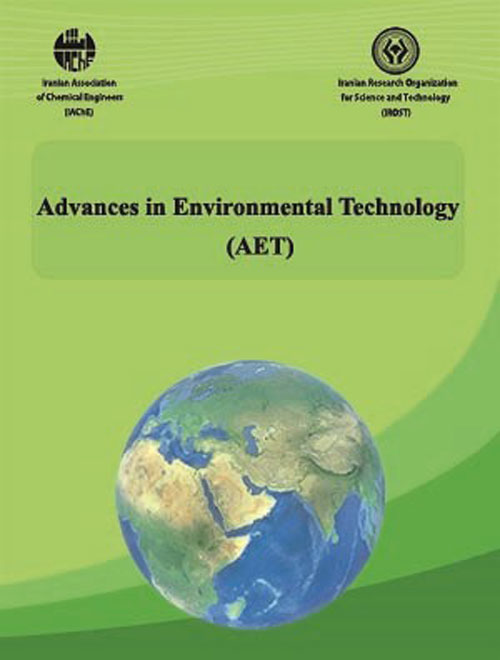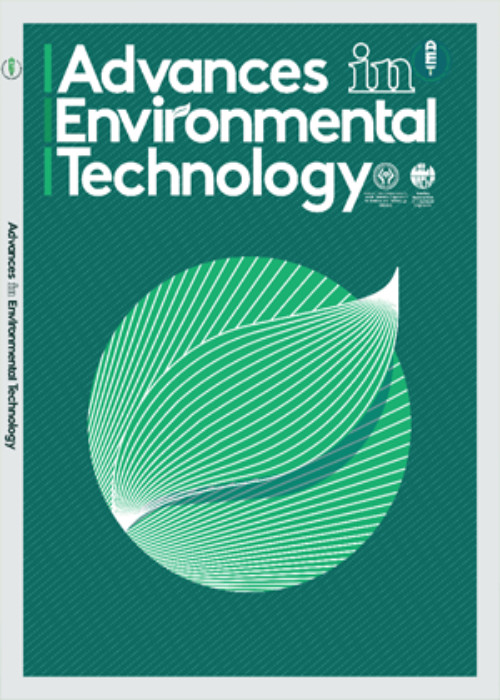فهرست مطالب

Advances in Environmental Technology
Volume:5 Issue: 1, Winter 2019
- تاریخ انتشار: 1399/04/11
- تعداد عناوین: 6
-
-
Pages 1-8
In this study, La–Mn–Cr perovskite-type catalysts were synthesized as LaMnO3,LaCrO3, and LaMn0.5Cr0.5O3 by a microwave-assisted gel-combustion method. They were then calcined at 600oC for 5h in air. X-ray diffraction (XRD) analysis indicated that the crystalline perovskite phase is the dominant phase formed in all the synthesized samples. The scanning electron microscopy (SEM) analysis showed that the perovskites have a full spongy and porous structure. The specific surface area (BET) analysis showed a specific surface area of about 12.4-26.8 m2/g, and the highest specific surface area belonged to the LaMn0.5Cr0.5O3 perovskite. Moreover, the highest oxygen mobility revealed by the temperature-programmed desorption of oxygen (O2–TPD) analysis was related to the LaMn0.5Cr0.5O3 sample. The catalytic activity of the synthesized perovskites in catalytic oxidation of 1000 ppm trichloroethylene (TCE) in air was investigated at different temperatures. The substituted perovskite (LaMn0.5Cr0.5O3) with the highest BET specific surface area and the highest oxygen mobility yielded the best catalytic performance among the probed perovskites.
Keywords: Perovskite, Catalyst, Oxidation, Volatile Organic Compound, Gel–Combustion -
Pages 9-21
In this work, the fast remediation of tert-butyl mercaptan from the polluted soil via a bimetallic Fenton treatment that included Fe2+/Fe3+/Fe0/Cu2+ in the presence of gasoline was studied. The analysis of variance and the Pareto analysis resulting from the central composite design (CCD) showed that the H2O2, CuSO4, Fe3O4 nanoparticles, nano zerovalent iron (nZVI), and gasoline initial concentrations as a secondary contaminant were influential factors on the removal efficiency of tert-butyl mercaptan (with an effectiveness of 2.09%, 13.38%, 1.92%, 2.01%, and 39.73% respectively). Moreover, the interaction of H2O2/nZVI, H2O2/nFe3O4, H2O2/CuSO4, nZVI/nFe3O4, and nZVI/CuSO4 had a positive effect on removal efficiency, while nFe3O4/CuSO4 had a negative one. Surprisingly, the mixing of nZVI and nFe3O4 before adding them to the reactor did not affect the removal efficiency. The optimum conditions suggested for the maximum removal efficiency of tert-butyl mercaptan were the minimum levels of the initial gasoline concentration (2.5 %w/w), a maximum level of CuSO4 (0.12 %w/w), and an optimum concentration of H2O2, nano-ZVI, and nano-Fe3O4 (8.92 %w/v, 0.1194 %w/w and 0.0898 %w/w, respectively) in the studied intervals. This condition led to a 99.27% efficiency removal of tert-butyl mercaptan removal in 20 minutes without pH and temperature adjustments.
Keywords: bimetallic, Modified Fenton, Remediation, tert-butyl mercaptan, Optimization -
Pages 23-33
Desulfurization-hydrogenation of thiophene and benzothiophene in hexadecane as a model diesel fuel was studied through a divided cell with the incorporation of the membrane electrode assembly (MEA) under different current density at a constant charge. The reduction of thiophenic compounds was investigated using prepared MoS2 nano-electrocatalyst and Nafion (commercial proton exchange membrane) and synthesized sulfonated poly ether ether ketone, SPEEK. The MoS2 electrocatalyst was characterized by field emission scanning electron microscopy and X-ray diffraction, which confirmed the formation of ball-like nano-thread of MoS2 with the size of 23-25 nm. Also, the electrocatalyst and/or MEA was electrochemically analyzed by cyclic voltammetry, linear sweep voltammetry, and electrochemical impedance spectroscopy. The gas chromatography-mass spectroscopy analysis of reactants and products revealed the direct desulfurization on thiophene reduction process and desulfurization along with desulfurization pathway on benzothiophene reduction experiment. Maximum desulfurization efficiency of 79.6% at 20 mA cm-2 and 51.5% at 30 mA cm-2 under the constant charge of 300 C was obtained for thiophene using MoS2-Nafion and MoS2-SPEEK system respectively. Moreover, maximum hydrogenation and desulfurization efficiency of 28% and 59.1% occurred at 50 mA cm-2 and 70 mA cm-2 respectively for Benzohiophene-Nafion system under the constant charge of 400 C. distribution of products affirmed the more contribution of desulfurization reaction at higher current density against the hydrogenation process at lower current density.
Keywords: Hydrogenation, Desulfurization, Thiophenic, MoS2 electrocatalyst, Membrane-electrode assembly -
Pages 35-45The wrinkling of cotton fabric is an important factor that affects a garment's appearance. This paper evaluated the use of a non-toxic green anti-wrinkle material in the finishing process to address this issue. For this purpose, the chemical structure of the wrinkled cotton sample was evaluated and treated with a scouring and anti-creasing finishing material. Due to the environmental issues created by the toxic material used as finishes, the type of anti-wrinkle material used in this study had the least possible environmental impact. The mechanism of this anti-crease finishing was based on the crosslinking of cellulose molecular chains. This process limited the chain movements made by wrinkling. Accordingly, the effect of the mentioned mechanism and structural parameters such as the thickness, weight, density of the weft yarn, and linear density of the weft yarn (Ne) were evaluated. The wrinkle degree of the samples was analyzed by using a radial basis function neural network (RBFN). This RBFN modeled the relationships between the degree of wrinkling in the fabrics and the mentioned parameters, especially the anti-crease finishing of the samples. The simulation results confirmed the effectiveness of the proposed method.Keywords: Green Technology, cellulose chain, Wrinkle development, anti-Wrinkle Finishing, Neural Network
-
Pages 47-53The study presented in this article investigated the removal of a long chain anionic surfactant from residential laundry wastewater using Jackfruit (Artocarpus heterophyllus) seeds. The main ingredients of laundry wastewater are the surfactants. Therefore, great attention should be given on the treatment and disposal of laundry wastewater. The use of natural substitutes in treating waste water has no harmful effects and it is considered an effective step towards protecting the environment and promotes sustainability. Jar test experiments were conducted in order to determine the optimum conditions for the removal of surfactants, chemical oxygen demand (COD), biological oxygen demand (BOD) and turbidity in terms of effective dosage, and pH control. At the optimum initial pH value of 6, optimum dose of 2.5 g/L, and optimum mixing time of 25 minutes the surfactant, COD, BOD and turbidity removal efficiencies were 91.66%, 82.86%, 77.66% and 85.14%, respectively. It can be concluded that Artocarpus heterophyllus seed powder was a feasible and cost effective natural coagulant for the removal of anionic surfactant from laundry waste water. Results showed that the pseudo second order equation is the suitable model for this system.Keywords: Jack fruit seed, Coagulation, laundry waste water, anionic surfactant
-
Pages 55-65A TiO2/Fe2O3/GO photocatalyst is synthesized via the sol-gel method and characterized by X-Ray Diffraction (XRD), X-Ray Fluorescence (XRF), FT-IR, Brunauer-Emmett-Teller (BET), and Ultraviolet-Visible Diffuse Reflection Spectroscopy (UV-Vis DRS) analyses. Metronidazole (MET) concentration (10-20 mg/L), photocatalyst concentration (0.5-1.5 g/L), irradiation time (60-120 min), and initial pH (4-6) are investigated through response surface methodology (RSM), and the optimal process conditions are determined. The removal efficiency of MET with the TiO2/Fe2O3/GO photocatalyst is 97% under optimal conditions: a pollutant concentration of 10 mg/L, the irradiation time of 120 min, photocatalyst concentration of 1 g/L, and pH of 5. The influence of mineral salts concentrations (50-800 mg/L), including NaCl, Na2SO4, NaHCO3, KCl, MgSO4, and CaCl2, are examined at the initial pH of 5, photocatalyst concentration of 1 g/L, and pollutant concentration of 20 mg/L. According to the results, the reaction rate constant decreases with an increase in mineral salts concentrations up to 800 mg/L, especially with Na2SO4 (42.43% deactivation) and also with MgSO4 (38.08%) and NaHCO3 (37.73%), under the same operational conditions. The effects of mineral salts such as NaCl and KCl on the reaction rate constant for the contaminant removal efficiency have a downward trend until these salts reach a 200 mg/L concentration, and then they experience an upward trend.Keywords: Mineral salts, Reaction rate constant, Titanium dioxide, Graphene Oxide, Iron oxide (III)


